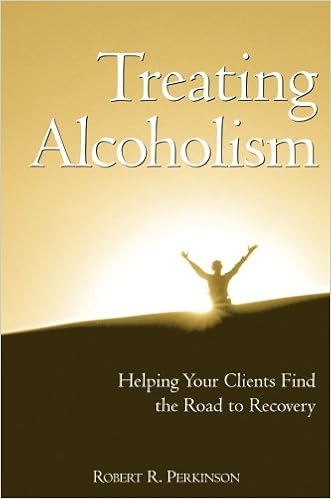Teenage Drug Abuse and Teenage Rehab
I'm Dr. Robert R. Perkinson
I specialize in alcoholism treatment, drug abuse treatment, teen drug abuse treatment, and problem gambling treatment. I have been treating alcoholics and addicts for over 30 years and have written the leading treatment manual for addiction counselors in the world. I thought I would give you an opportunity to learn more about addiction.
The Chemically Dependent Adolescent
The tumultuous group of adolescents comprises 20% of the adolescent population. These adolescents come from family backgrounds that are not stable. There often are histories of mental illness in these families, the parents often have marital conflicts, and the families often have economic difficulties. The moods of these adolescents are not stable, and these individuals are more prone to depression. They have significantly more psychiatric disturbances, and they do well only with the aid of intense psychotherapy. They do not grow out of it (Masterson & Costello, 1980; Offer, 1986). It is in the tumultuous growth group that chemical dependency often develops.
In this country, the average first use of mood-altering chemicals for boys is 11.9 years and for girls is 12.7 years (U.S. Department of Justice, 1983). Adolescents almost always use alcohol or drugs for the first time under peer pressure. They want to be accepted and to be a part of the group. Children are likely to model after the chemical use of their parents. Children with alcoholic parents are at greater risk for becoming chemically dependent (Spalt, 1979).
Adolescents who continue to use will increase drinking to a regular pattern (usually weekends). They may experiment with other drugs. They begin to use drugs to communicate, to relate, and to belong. With regular drinking, tolerance develops. The adolescents need more of the drug to get intoxicated. Emotional changes may first be noticed here by their families. The adolescents may become irritable and more noncommunicative. They may begin to spend more time alone in their rooms. They may begin not caring for themselves or for others. Polarization of parents and children begins to occur (Morrison & Smith, 1990).
As chemical dependency further develops, adolescents no longer can trust themselves when using chemicals. The choice to use these drugs no longer is available to them; they have to use to feel normal. The continued use of chemicals eliminates the ability to think logically and rationally. Rationalization, minimization, and denial cut the adolescents off from reality (Soujanen, 1983).
Chemically dependent adolescents gradually change their peer group to include drinking and drug-using friends. They begin to use chemicals to block out the pain. They no longer use for the euphoric effect. They drink to escape pain. Blackouts and drinking alone are strong indicators of chemical dependency in the adolescent population. With the progression of the disease, family conflicts increase. The adolescents may run away, withdraw, or act out at home and at school. They withdraw from family and community activities. Problems with the police and school officials increase and become serious. The adolescents may become verbally abusive to parents and more rebellious to authority figures. Life begins to center around alcohol or drugs. Daily use begins, and these individuals begin to use to maintain rather than to escape. The adolescents make attempts to cut back or quit, but they are unable to stay clean and sober. Physical deterioration begins. Hiding and lying about drugs becomes more common. The adolescents feel more intensely isolated and alone. Concern is now openly expressed by parents, teachers, and even peers. Gradually, the adolescents lose all self-esteem and depression begins. Persistent chemical use leads to incarceration, institutionalization, or death (Chatlos & Jaffe, 1994; Morrison & Smith, 1990).
Chemical dependency halts emotional development. To develop normally, people must learn to use their feelings to give them energy and direction for problem solving. When feelings are consistently altered by alcohol or drugs, this no longer is possible. The major coping skill of chemically dependent persons is chemical use.
Adolescent chemical dependency can occur extremely quickly—within weeks—because these individuals’ emotional development is immature. Adolescents do not have the internal structure to bring themselves and their lives under control. They cannot delay the onset of chemical dependency for years as can adults.
Children believe that alcohol and drug use is safe. The average 18 year old has seen 100,000 television commercials encouraging him or her to drink. That's why 80% of high school seniors have tried alcohol, 32% have gotten drunk in the last thirty days, 43% smoke marijuana, and about one third are smoking cigarettes.
This is a national catastrophe!
If you think that you or someone you love has a problem with alcohol, drugs or gambling, the fact that you are reading this page is an incredible victory. It means you are thinking about getting help. Congratulations! An addict has only two choices get into recovery or die.
The first thing you need to do is see if there is an addiction problem. Answer these questions and be honest with yourself. You can answer the questions for yourself or the person you are concerned about. You have nothing to hide and nobody is going to know the results but you.
Has the person ever tried to cut down on his or her use?
Have people annoyed the person by talking to him or her about the use?
Has the person ever felt bad or guilty about his or her use?
Has the person ever used alcohol or drugs in the morning or broken the law to use?
Two or more of these questions answered yes indicates probable addiction. That means you are in trouble and you need help. Only 4% of addicts can quit on their own for the next year.
It is not just the addict who suffers. Everyone associated with an addicted person is under terrible stress. This will just get worse until you get into treatment.
If you or someone you love is addicted, you need to take action now! Don't let someone die because you stalled. I know you are afraid, but you don't have to be.
If you are an addict, or live with one, you are in great pain. Most addicts die of their addiction and they take their family members down with them. The first step in recovery is to get honest with yourself. Don't just sit there and think things are going to get better. Addiction doesn't get better. It gets worse until somebody dies. You need to take action and you need to take action now. The worst thing you can do is wait. How are you going to feel if this person kills someone in an accident or kills themselves? Don't let this happen to your family. It's time to get help. Call us for a free assessment at 1-800-992-1921. There is no obligation and you don't even have to tell us your name. We can help you get treatment in your area or we can help you come to our treatment center. We are a small treatment center where you won't get lost in the shuffle. We have a number of programs designed for specific populations such as duel diagnosis, cognitive deficits, gambling problems, a Christian program, an adolescent program, a young adult program, a Native American program and many more. We are very flexible about the cost of treatment. Most patients come into treatment at reduced rates. Many patients are state funded or come into treatment under Medicaid. If you are worried about the money, don't let that stop you. Money is the least of your worries. The money is not going to kill anyone and addiction kills everyone. Let us help you find a treatment you can afford. If you are an addict or if you live with one you are living in hell, you have no peace. Nothing you have tried works and you keep returning to the pain.
Find a treatment facility near you
 Chemical Dependency Counseling: A Practical Guide, Fifth Edition: is a best-selling comprehensive guide for counselors and front-line professionals who work with the chemically dependent and addicted in a variety of treatment settings. The text shows the counselor how to use the best evidence-based treatments available, including motivational enhancement, cognitive behavioral therapy, skills training, medication and 12 step facilitation. Guiding the counselor step-by-step through treatment, this volume presents state-of-the-art tools, and forms and tests necessary to deliver outstanding treatment and to meet the highest standards demanded by accrediting bodies.
Chemical Dependency Counseling: A Practical Guide, Fifth Edition: is a best-selling comprehensive guide for counselors and front-line professionals who work with the chemically dependent and addicted in a variety of treatment settings. The text shows the counselor how to use the best evidence-based treatments available, including motivational enhancement, cognitive behavioral therapy, skills training, medication and 12 step facilitation. Guiding the counselor step-by-step through treatment, this volume presents state-of-the-art tools, and forms and tests necessary to deliver outstanding treatment and to meet the highest standards demanded by accrediting bodies.
 The Alcoholism and Drug Abuse Client Workbook, Third Edition:An evidence-based program that uses treatments including motivational enhancement, cognitive-behavioral therapy, skills training, medication, and 12-step facilitation. It provides a venue for clients to write down their thoughts and experiences as they progress through treatment.
The Alcoholism and Drug Abuse Client Workbook, Third Edition:An evidence-based program that uses treatments including motivational enhancement, cognitive-behavioral therapy, skills training, medication, and 12-step facilitation. It provides a venue for clients to write down their thoughts and experiences as they progress through treatment.
 The Gambling Addiction Client Workbook, Third Edition:An evidence-based program that uses treatments including motivational enhancement, cognitive-behavioral therapy, skills training, medication, and 12-step facilitation. This workbook walks clients through self-reflective activities and exercises meant to help them recognize the underlying motivations and causes of their gambling addiction and to learn the tools necessary for recovery. The Third Edition of this workbook includes coverage of all 12 steps of recovery. Chapters focused on honesty and relapse prevention as well as a personal recovery plan contribute to client success.
The Gambling Addiction Client Workbook, Third Edition:An evidence-based program that uses treatments including motivational enhancement, cognitive-behavioral therapy, skills training, medication, and 12-step facilitation. This workbook walks clients through self-reflective activities and exercises meant to help them recognize the underlying motivations and causes of their gambling addiction and to learn the tools necessary for recovery. The Third Edition of this workbook includes coverage of all 12 steps of recovery. Chapters focused on honesty and relapse prevention as well as a personal recovery plan contribute to client success.
Treating Alcoholism: Helping Your Clients Find the Road to Recovery:
Alcoholics are one of the most difficult client groups to treat effectively. To preserve their way of life, they may lie about their problem or deny that one exists; that is the nature of this profoundly powerful disease. Yet if you can guide each of your clients through their own resistance towards the truth, not only will you be rewarded with starting them on the road to recovery, you will no doubt have saved their life as well. Achieving such a victory goes to the heart of being an addiction counselor; it is the experience of healing on a direct and tangible level.
Treating Alcoholism provides a complete road map for assessing, diagnosing, and treating this multifaceted and tenacious illness. Detailed clinical information on the disease accompanies ready-to-use tools for practice. With a special emphasis on the 12 Steps of Alcoholics Anonymous, the author walks you through the first five steps of this established methodology in comprehensive detail, showing how to easily apply each one to treatment.
The Big Book of Alcoholics Anonymous says that only God can relieve the illness of addiction. Here are a few spiritual tools to help you:
 God Talks to You: Second Edition: God wants to communicate with you. God has been calling you for a long time. You have wanted God to speak to you for a long time. You have wanted to talk to God and get answers back. Here are a few quotes from spiritual leaders who have read the book: Reverend Mark Holland: “After reading Dr. Perkinson's book, I spent several minutes quieting myself, and then I asked God if there was a message for me. “Mark I’ve missed you!” Although there were no words spoken, I felt this message very clearly. I was quite surprised. Daily I was involved with spiritual matters, praying, preaching, and counseling. Nevertheless, I discovered that God was lonely for me.” Reverend Dave Waldowski: “This book and tape do not only “discuss” communication with God, moreover if you follow these simple principles you will “experience” and “hear” God’s voice on a daily basis.”
God Talks to You: Second Edition: God wants to communicate with you. God has been calling you for a long time. You have wanted God to speak to you for a long time. You have wanted to talk to God and get answers back. Here are a few quotes from spiritual leaders who have read the book: Reverend Mark Holland: “After reading Dr. Perkinson's book, I spent several minutes quieting myself, and then I asked God if there was a message for me. “Mark I’ve missed you!” Although there were no words spoken, I felt this message very clearly. I was quite surprised. Daily I was involved with spiritual matters, praying, preaching, and counseling. Nevertheless, I discovered that God was lonely for me.” Reverend Dave Waldowski: “This book and tape do not only “discuss” communication with God, moreover if you follow these simple principles you will “experience” and “hear” God’s voice on a daily basis.”
Peace Will Come CD Sit back and let the words and music sink into your soul. Come back often and play the songs over and over again. You won't be sorry. God will teach you many things you need to know.
A Communication From God: A meditation tape that will give you long communications from God. The tape takes you through two exercises where God speaks to you directly.
Addiction stops your spiritual progress.
Trevor Howard, the sheriff of Teton County Wyoming, is contemplating an explosion of cocaine addiction, four structure fires and the murder of a six-year-old boy in his jurisdiction. The boy had a wooden cross penetrating his heart indicating a possible religious connection. Trever has the idea of hiring a young woman deputy with experience in undercover narcotics investigation. Simultaneously, Doctor Abe Anderson, Trevor’s best friend, meets Heather Cutler, acting in a play as the red headed demon of seduction. Abe falls in love with her and even more with his first experience with cocaine. Trevor is usually a confident police officer but these crimes, coming all at once, leave him feeling deeply troubled. Before it’s done his whole life, friendships and family will show him how terribly he has underestimated his greatest fears.
Joan Worthing has a new job as a seasonal ranger in Yellowstone National Park. She is hoping to escape a long history of physical and sexual abuse by her brother Teddy who is schizophrenic. Teddy escapes from a mental hospital and rushes to find her. He believes she must have his child who will save the world from an alien invasion. He is desperate to find Joan and save the world. Doctor Rand Holland, a psychologist in new recovery from alcoholism, becomes involved in the search for Teddy and the protection of Joan. One of Rand’s teenage patients Lela Lander runs away from home seeking help from Rand. She becomes involved with a Satanic coven in Denver run by Lonn Majors. All these characters meet in Yellowstone as the coven holds a Halloween ritual sacrifice that will bring Satan to earth for the ultimate battle between good and evil.
Begin a new spiritual journey:www.godtalkstoyou.com
Read the latest research for a school paper or project from the National Library of Medicine












